|

Huntington Avenue Grounds
400 Huntington Avenue
Boston, MA
Home of the
Boston Americans
a.k.a. Somersets, Pilgrims, Red Sox
(1901-1911)
World Series
- 1903: Boston/Pittsburgh
All-Star Games
(None)
Overview
- Opened: 1901
- Updates: Undetermined
- Signature: Tool shed
- Closed: 1911
- Demolished: ca.1912
- Remains: None
- Site: Northeastern Univ
Site Memorials
- Cy Young Statue
- Home Plate Plaque
- Left Foul Line Plaque
- Memorabilia Display
Vital Stat Links
- Official History
- Map
- Aerial View
(Cached)
- Ballparks.com
- Diamond Legends
Photo Links
- Boston Public Library 1
- Boston Public Library 2
- NU (360 viewer)
Article Links
- Ballpark-Watch.com
- Baseball-Almanac.com 1
- Baseball-Almanac.com 2
- BaseballLibrary.com
- Boston Globe, 1903
- Boston Magazine
- Elysian Fields Quarterly
- Lou Criger
- NU: Charles Fountain
- NU: First World Series
- RedSoxDiehard.com
- RedSoxConnection.com
- RoyalRooters.com
- SaveFenwayPark.com
Cy Young Pages
- Baseball-Almanac Obit
- BaseballLibrary.com
- FindAGrave.com
- Hall of Fame
- May 5, 1904
- Official Bio Site
- Terra.com
- TheBaseballPage.com
Related Pages Here
EXHIBITS
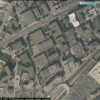
Former site of Huntington Avenue Grounds

From the 1908
Bromley Atlas of Boston

1903 World Series
program cover

Souvenir card from the 1903 World Series

1903 Cy Young
baseball card
 VIDEO VIDEO 

The courtyard

Cy Young statue
 AUDIO AUDIO 

A recording of "Tessie" reportedly made on October 5, 1903, in between games of the first World Series
HISTORICAL PHOTOS

Panorama, 1904

Infield panorama, 1904

Young at Huntington, 1908

Cy Young, official portrait

The lone entrance gate on Huntington Avenue

Eager and aggressive fans find an alternate entry

Undated photo shows hazards between dugout and plate

From 1905, the legendary tool shed is clearly visible in the background

Relaxing in the
outfield weeds

A group of policemen pose in the home team's dugout

The 1903 Pirates in the visitor's dugout

Fans waiting to enter
before game 3 of the
1903 World Series

The Royal Rooters
in dangerous territory
on the field

A closer look at the
Royal Rooters

Undated photo featuring Ban Johnson (with cigar)
at the park

View from the grandstand

That little screen isn't protecting anyone

Fans stream out of the stands after a game

The crowd down the
right field line

Walkway behind the grandstand (main entrance visible in the background)

Cy Young (right) ca. 1905
RECENT PHOTOS

Overview of the site today

The Cy Young statue

Huntington Avenue and the Cabot Center plaque

The Young statue is exactly 60 feet 6 inches away

Courtyard at
World Series Way

Statue close-up

Statue inscription
|
|
 |
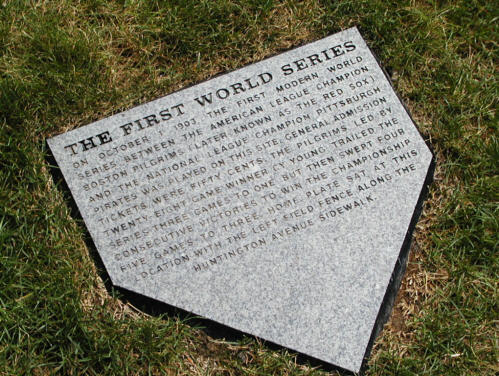 |
|

By Rick Prescott
Fall 2002
At the heart of the campus of Northeastern University in Boston stands a reminder of baseball's glorious past: a statue of Cy Young, poised to pitch near the very same spot where the legend himself threw in the first ever World Series. This quiet quadrangle, appointed with trees, quaint lamp posts, benches, and gently curving walkways, is where the infield of Huntington Avenue Grounds once stood.
The tranquility and refined nature of the courtyard is a long way from the more rough and tumble ballpark which once stood here. The massive playing field, which boys used to climb tall poles to see, is now covered with burly academic buildings, tightly packed together in a positively Tetris-like fashion. Yet somehow, in a stroke of good fortune, the buildings part right where needed to memorialize an unforgettable park and pitcher.
Other forces have conspired to make sure that another aspect of the site has not changed in the intervening century: it is still bordered to the north and south by active railroad tracks.
|
|
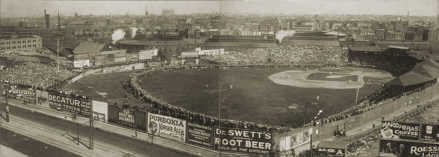
|
|
In the foreground of the above photo you can see the trolley tracks running down the middle of Huntington Avenue. No doubt this is how most of the fans arrived at the park. Today these tracks carry the MBTA Green Line subway trains, and still stop just about where the park entrance used to be. In the background, the dark buildings and roundhouse straddle what is today an Amtrak commuter line, but back then carried mostly freight trains. These dingy and ominous buidings -- and their plumes of smoke -- give a glimpse at why the site was ultimately abandoned. (Just beyond those buildings, though not discernible in this photo, was the home of the other Boston baseball team.)
Brief History
Boston got its American League team in 1901 when the league was formed. The site for this park was selected by none other than
Connie Mack, dispatched for the task by league founder Ban Johnson. Seeking cheap land and a strategic location, he settled on this parcel, controlled at the time by the Boston Elevated Railroad, and typically used for traveling circuses, carnivals and rodeos. Best of all, it was just across the tracks from the rival National League park, the South End Grounds. This provided unusually high visibility for the new team and the new league, which had acquired some great players (like Young) for their venture. By locating so close, and setting prices at half what the National League was charging (25 cents versus 50 cents), they could assure quick success.
The park itself was built hastily in the two months before opening day at a cost of about $35,000. Made primarily of wood, it would turn out to be unfortunately prone to fires, and it's location (while good for business) also turned quickly into a liability due to excessive smoke from the nearby train
yards. In little more than a decade, the whole thing would have to be abandoned in favor of a better situated and more modern steel-and- concrete home: Fenway Park.
But in those wild 11 years, the park saw not only the first World Series but also the first modern perfect game, which was thrown by Young on May 5, 1904, against the Philadelphia Athletics. For a more detailed history, read the very fine article found at RedSoxConnection.
Sand, Wood and Smoke
It is said that the playing field, made up mostly of weeds and sand, sloped upward toward deep center. But this would have been only one of many hazards associated with playing here. Balls hit into a tool shed out there (which would have had to travel over 600 feet) were in play. Probably the most formidable obstacle might have been the fans who, when they weren't standing on the field behind ropes, apparently came out of the stands to aid in arguments with the umpires. That may be what happened to result in the unusual image shown below from a 1910 game against the Tigers.
|
|
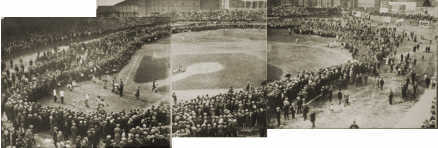
|
|
Despite wearing hats and coats to the games, it appears that this was a pretty rowdy bunch. It is well documented that they came primarily to gamble and drink (some things never change). They can be seen in photos to climb over fences both to get into the park -- and again to get out of it. There is only evidence of a single entry point for the entire structure yet it is apparent that those sitting in the distant centerfield bleachers could take a shortcut across the field to get to their seats. Given the bad field conditions, groundskeepers probably didn't mind.
But the fans on the field strategy reached its most absurd heights with the groups of dignitaries, such as the Royal Rooters, being seated directly behind home plate -- with no screen! Even though it was 90 feet to the backstop, this still seems like a recipe for bruised politicians and dented tubas.
Though many of the photos which survive show large crowds, this was not typically the case. With an official capacity of around 11,000 (and an unofficial capacity closer to 20,000), a typical game saw only about 5,000 fans. Still it is interesting to note that the strategy to draw fans away from the competition across the tracks appears to have worked: during this period the Nationals were typically drawing only 2,000 per game.
The park was decidedly asymetrical, starting with the main grandstand. Its roof covered the area from just to the first base side of home to well beyond third base, almost to the point where the stands cut in across the left field line. (In fact, the stands initially cut in at about 320 feet down both lines.)
Originally, the grandstand roof appears to have had six separate sections, each one complete with one or two flag poles. But by 1911 one of the roof sections had been modified to install a press box of sorts. Not much is known of the area beneath the grandstand, except to say that there was reportedly some standing room which was used to wait out rain delays.
The remainder of the stands, all made of wood, were uncovered. Out in straight-away center, they were also very remote from the action. This is what apprently led to the practice of allowing fans to form a de facto fence behind ropes strung across the outfield. This in turn led to the unusual practice of awarding ground rule triples for balls hit beyond the rope-constrained fans but not all the way to the wooden fence. It's fair to wonder if opposing players ever met resistance from fans while trying to make catches right at that squirming perimeter...
A seldom-mentioned feature of this park is the inclusion of simple arched windows at the rear of the main grandstand.
Though they only had a view of the walkway behind the stands, they did serve to connect the park with its surroundings. Of course, this park was not just connected with its surroundings, it was inundated by them -- especially their scents. Neighbors to the park included a bean factory, pickle factory, breweries, stables, numerous saloons, and a particularly noxious chemical plant.
Bulky neighbors also dominated the view. Directly beyond left field across Huntington Avenue, the Boston Storage Warehouse (visible in a photo at Ballparks.com) made for a formidable -- and very visible -- neighbor. And right next door to the warehouse,
beyond the stands in left-center, was the classical facade of the Boston Opera House. These two buildings were as much a part of this park as the tool shed.
To the south, the round- houses, warehouses, and other support structures of the rail yard also regularly made their presence known. It's well documented that there were times when the wind was blowing just right and the fans might be overcome by smoke from these buildings or even passing trains. Ultimately, it was the neighborhood which determined the fate of the Huntington Avenue Grounds, and led to the birth of one of the game's greatest parks ever.
Well Remembered
After its all-too-brief glory days, the park was abandoned, and the land reverted to being home to circuses, large outdoor events, and most notably something called Billy Sunday's Tabernacle. Sunday was a traveling evangelist who drew extremely large crowds
to his tent revivals. The Royal Rooters followed the Red Sox to Fenway Park, but the famous McGreevey saloon disappeared when the country went dry.
Northeastern University acquired the site many years later, and erected the plaque honoring the site's history on the outside of Cabot Center in 1956. Nearly 40 years later in 1993, the president of the university, John A. Curry, initiated the project which would lead to a more elaborate memorial to the park in the courtyard now known as World Series Way. The university, together with the Yawkey Foundation, commissioned sculptor Robert Shure to create the statue of Cy Young.
"The location of the statue was dictated by the buildings and the park, which were designed and built years before the statue," explains Vin Lembo of Northeastern University. "It faces the wrong way, west instead of southwest, so that we could install a home plate on the mound of grass in the middle of the part 60 feet 6 inches away from the statue." The misalignment he speaks of is evident from the aerial photographs. The original park's orientation was essentially northeast/southwest.
So is the statue really where Cy Young used to pitch -- even if it does face slightly the wrong direction? By superimposing
the detailed 1908 Bromley survey map over a modern aerial photo and scaling them to the same size, it's possible to confirm that it does indeed sit on or very near to the original location of the pitching mound. And while approximating the location would certainly be forgiveable, it appears that fortune smiled upon the designers of the campus, and made this remarkable detail possible.
Standing near the statue on a sunny summer day, this place does feel like it's still a part of the game. Of course, the games and seasons here ended long ago, and like all ballparks will eventually, this one has faded away. But what happened here has not. What Cy Young did here a century ago is the yardstick by which pitchers forever will be measured. That makes this little patch of ground unique, and makes it feel relevant to what's going on just across the Fens, and around the world of baseball. That's certainly some lingering ballpark magic.
|
|
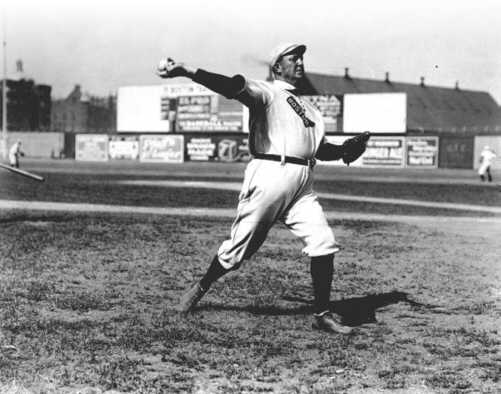 |
|